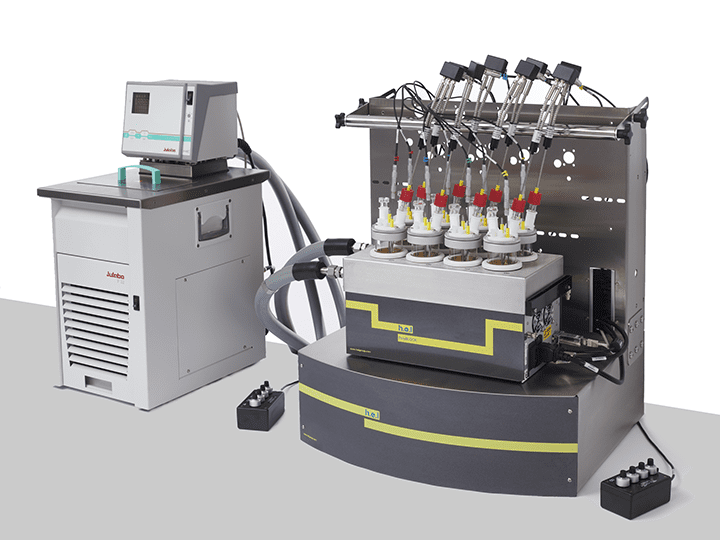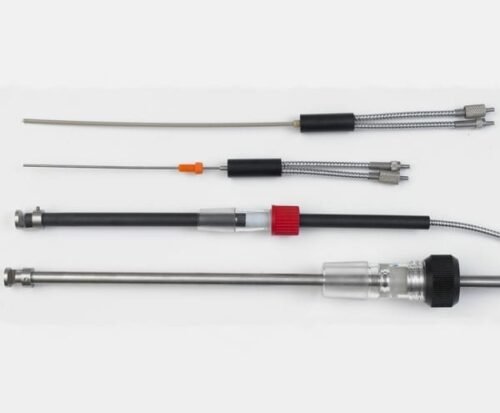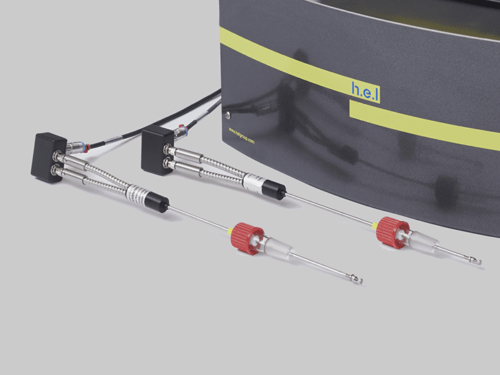CrystalSCAN | Parallel Crystallization Monitoring Platform
The CrystalSCAN is a bench-top, automated, parallel crystallization monitoring platform, facilitating determination of solubility curves and the MSZW (metastable zone width) of multiple samples, and optimization of the desired crystallization process. The standard system supports 8, independently controlled reactors, each equipped with H.E.L’s proprietary crystallization monitoring probe, CrystalEYES.
In addition to automated stirring, heating, and cooling of each sample, the CrystalSCAN can automatically add solvent/anti-solvent of choice, diluting each sample independently at the end of each cycle. Consequently, data on the points of dissolution and the points of nucleation can be determined automatically under a range of experimental conditions, enabling solubility curves to be generated and the characterization of MSZW, respectively. While the former provides the basis for optimizing the desired crystallization process, the latter provides insights into the behavior of the process on larger scales, informing and facilitating process development.
This combination of high throughput, coupled with high data content, accelerates the development and optimization of the desired crystallization process and shortens time to commercialization.
Publications
The following are a list of some technical publications which highlight the use of the equipment.
Development of a Calibration Model for Real-Time Solute Concentration Monitoring during Crystallization of Ceritinib Using Raman Spectroscopy and In-Line Process Microscopy
Matea Gavran, Željka Ujević Andrijić, Nenad Bolf, Nikola Rimac, Josip Sacher and Damir Šahnić
13-Dec-2023
https://www.mdpi.com/2227-9717/11/12/3439(Subscription or purchase maybe required for full access)
Crystallization Behavior of Ceritinib: Characterization and Optimization Strategies
Iva Zokić and Jasna Prlić Kardum
25-Aug-2023
https://www.mdpi.com/2305-7084/7/5/84(Subscription or purchase maybe required for full access)
Determination of Nucleation Kinetics from the Induction Time of 1,1-Diamino-2,2-Dinitroethylene (FOX-7) in DMSO/Water
Siqi Fan, Xiaofei Gu, Xin Zhou, Xiaohui Duan, Hongzhen Li
01-Dec-2020
https://doi.org/10.1016/j.enmf.2020.12.006(Subscription or purchase maybe required for full access)
Study of the Solubility, Supersolubility and Metastable Zone Width of Li2CO3 in the LiCl−NaCl−KCl−Na2SO4 System from 293.15 to 353.15K
Huaiyou Wang, Baoqiang Du, and Min Wang
01-Apr-2018
https://doi.org/10.1021/acs.jced.7b01012(Subscription or purchase maybe required for full access)
L-Tyrosine production by recombinant Escherichia coli: Fermentation optimization and recovery
Ranjan Patnaik, Raymond R. Zolandz, Daniel A. Green, David F. Kraynie
01-Dec-2017
https://doi.org/10.1002/bit.21765(Subscription or purchase maybe required for full access)
Solubility of 1,1-diamino-2,2-dinitroethylene in different pure solvents and binary mixtures (dimethyl sulfoxide + water) and (N,N-dimethylformamide + water) at different temperatures
Lu Liu Hongzhen Li Dong Chen Xiaoqing Zhou Qi Huang Haijun Yang
01-Dec-2017
https://doi.org/10.1016/j.fluid.2017.12.035(Subscription or purchase maybe required for full access)
Solubility, Metastable Zone Width, and Nucleation Kinetics of Boric Acid in the NaCl–KCl–CaCl2–H2O System
Jiaoyu Peng,†,‡ Naijin Dong,†,‡ Yaping Dong,*,† Zheng Pan,§ and Wu Li
01-Oct-2015
https://doi.org/10.1021/acs.jced.5b00581(Subscription or purchase maybe required for full access)
Cooling crystallization of aluminum sulfate in pure water
Xiaoxue Sun Yuzhu Sun Jianguo Yu
01-Mar-2015
https://doi.org/10.1016/j.jcrysgro.2015.03.005(Subscription or purchase maybe required for full access)
Evaluation of the difficulty of crystallization of organic compounds using the critical supersaturation ratio (Sc)
Daiki Nagamatsu Yasuo Ida Hiroshi Takiyama
01-Aug-2014
https://doi.org/10.1016/j.jcrysgro.2014.08.012(Subscription or purchase maybe required for full access)







